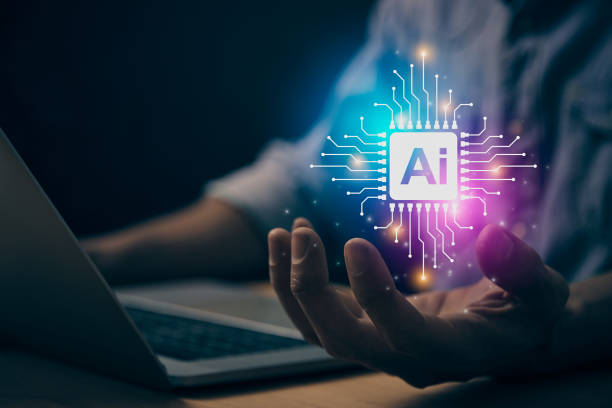Introduction to SEO and its Importance
![]()
In today’s digital world, visibility among a multitude of websites is more critical than ever.
This is where the concept of SEO or Search Engine Optimization shows its importance.
#SEO is a process that helps your website achieve a better ranking in the organic search results of search engines like Google, Bing, and Yahoo.
The main goal of #SEO is to increase the quality and quantity of your website’s traffic through unpaid search results.
A strong #SEO strategy not only attracts more visitors but also helps businesses gain more credibility and trust online.
This topic is, in fact, an educational and continuous approach that requires constant updating with the changing algorithms of search engines.
Understanding the fundamentals of SEO is a necessity for anyone who wants to have an effective online presence.
In this guide, we will explanatorily and step-by-step delve into various aspects of website SEO and guide you on the path to improving your ranking and visibility in search results.
Did you know that customers’ first impression of your company is your website? Multiply your business’s credibility with a powerful corporate website from Rasawb!
✅ Exclusive and eye-catching design tailored to your brand
✅ Improved user experience and increased customer acquisition
⚡ Get a free consultation!
On-Page SEO and Its Key Factors

On-Page SEO refers to all actions taken within your website to improve its ranking in search engines.
This includes optimizing content and HTML code.
One of the most important factors in this section is the optimal use of keywords.
Keywords should be naturally placed in page titles, meta descriptions, headings (H1, H2, H3), and the main content text.
Page titles (Title Tags) should be appealing and contain the main keyword, as they are the first thing users see in search results.
Meta descriptions, although not directly impacting ranking, play a significant role in increasing the click-through rate (CTR).
URL optimization, using Alt tags for images, and internal linking structure are other vital components of on-page SEO.
For example, ensuring your images are saved with relevant names and descriptive Alt tags helps search engines better understand your visual content.
This specialized approach focuses on optimizing internal elements and forms the foundation of a comprehensive content SEO strategy.
By strictly adhering to these points, you can provide a better user experience not only for search engines but also for users, which will indirectly impact your SEO ranking improvement.
Off-Page SEO and the Role of Backlinks

Off-Page SEO refers to all activities performed outside your website aimed at improving its ranking in search engine results.
The most important and influential factor in off-page SEO is building quality backlinks.
Backlinks are essentially votes of confidence from other websites to your site.
The greater the number and quality of backlinks, the more reputable and authoritative search engines consider your website.
However, not all backlinks are equal; a backlink from a reputable website relevant to your field of work is far more valuable.
There are various methods for building backlinks, including: creating valuable and shareable content, participating in forums and social networks, guest posting on other blogs, and connecting with influencers.
Activity on social networks, although not directly affecting ranking, helps increase content visibility and consequently attracts natural backlinks.
This part of off-page SEO is a complex and time-consuming process that requires precise analytical strategies and immense patience.
The key differences between on-page and off-page SEO are presented in the table below:
| Feature | On-Page SEO | Off-Page SEO |
|---|---|---|
| Location of Activity | Within the website | Outside the website |
| Control | Full control | Limited control (dependent on others) |
| Examples of Activities | Content optimization, site speed, URL, meta tags | Backlink building, social media activity, online PR |
| Main Goal | Enhancing content quality and relevance | Increasing site authority and trust |
Technical SEO and Its Importance for Crawling and Indexing

Technical SEO refers to the process of optimizing a website’s technical infrastructure so that search engines can easily crawl and index it.
Without proper technical SEO, even the best content might never appear in search results.
Site loading speed is one of the most crucial factors in technical SEO.
Both users and search engines prefer faster sites.
Tools like Google PageSpeed Insights can help you identify problems and improve site speed.
Mobile-friendliness is also of high importance, as most searches today are done via mobile devices, and Google prioritizes responsive websites.
A well-organized site structure, using a Robots.txt file to guide crawlers, an XML Sitemap to help search engines find all pages, and implementing an SSL certificate (HTTPS) for security are other key aspects of technical SEO.
Fixing 404 errors and implementing proper redirects also prevents crawl budget waste.
A specialized approach to technical SEO can provide a strong foundation for your other optimization activities and ensure that your website is correctly identified and evaluated by search engines.
Does your current website showcase your brand’s credibility as it should? Or does it drive away potential customers?
Rasawb, with years of experience in professional corporate website design, is your comprehensive solution.
✅ A modern, beautiful site tailored to your brand identity
✅ Significant increase in lead generation and new customer acquisition
⚡ Contact Rasawb now for a free consultation on corporate website design!
Keyword Research, the Cornerstone of Every SEO Campaign

Keyword research is the first, and perhaps most important, step in any successful SEO strategy.
This process involves finding phrases and words that your target audience uses to search for information, products, or services on search engines.
The goal is to identify keywords that not only have a suitable search volume but also reasonable competitiveness and relevance to your content.
Keyword research tools like Google Keyword Planner, Ahrefs, and Semrush can assist you in this process.
Identifying long-tail keywords, which are three words or more, can often lead to more targeted traffic with less competition.
Understanding user intent behind each keyword is also crucial.
Is the user looking for information (informational search), looking to buy a product (commercial search), or looking for a specific website (navigational search)? Choosing the right keywords allows you to produce more thought-provoking content and relevant content that precisely addresses your audience’s needs.
This educational approach to keyword SEO ensures that your SEO efforts are guided in the right direction and attract targeted traffic to your site.
Producing Quality Content and Content SEO

Content is king, and this statement holds true in the world of SEO more than ever.
Producing high-quality and valuable content not only helps attract and retain audiences but is also a key factor in improving site rankings in search engines.
Your content should be explanatory, comprehensive, and responsive to user needs.
This means that merely stuffing text with keywords is not enough; content must be original, accurate, and trustworthy.
Search engines, especially Google, prefer content that demonstrates expertise, authoritativeness, and trustworthiness (E-A-T).
Types of content include blog articles, infographics, videos, podcasts, and even user reviews.
Regularly updating old content and adding new information can also help maintain the freshness and relevance of your content.
An analytical strategy for content SEO involves continuously reviewing content performance, identifying weaknesses and strengths, and optimizing it based on data.
The ultimate goal is to provide content that is not only optimized for search engines but also offers an engaging and valuable experience for users.
This balance between optimizing for search engines and creating value for users, is the cornerstone of success in modern SEO strategies.
Monitoring and Analyzing SEO Performance

After implementing SEO strategies, monitoring and analyzing performance are essential to understand the effectiveness of your efforts and identify opportunities for improvement.
Tools like Google Search Console and Google Analytics are among the most important tools that allow you to collect vital data.
Search Console shows you how your website performs in search results, which keywords attract more traffic, and what technical issues might exist.
Analytics provides detailed information about user behavior on your site, including duration of visit, pages viewed, and bounce rate.
Key Performance Indicators (KPIs) in SEO include: keyword rankings, organic traffic, click-through rate (CTR), conversion rate, dwell time, and bounce rate.
Periodically reviewing these metrics and comparing them with initial targets helps you adjust your strategies.
This analytical and continuous process is vital for any SEO campaign and ensures that your resources are used effectively and purposefully.
Below are some key SEO performance indicators:
| Key Performance Indicator (KPI) | Explanation | Importance in SEO |
|---|---|---|
| Organic Traffic | Number of visitors via search engines (unpaid) | Direct indicator of SEO success |
| Keyword Ranking | Your site’s position in search results for specific keywords | Indicates your competitive position |
| Click-Through Rate (CTR) | Percentage of users who clicked on your link after seeing it in results | Important for title and meta description attractiveness |
| Bounce Rate | Percentage of users who visited only one page and exited the site | Indicates content relevance and user experience |
| Dwell Time | The duration users spend on your site | Importance for content quality and site engagement |
Common SEO Mistakes and Solutions to Avoid Them

In the process of search engine optimization, making common mistakes can render your efforts fruitless or even harm your website’s ranking.
One of the biggest mistakes is keyword stuffing, which is not only penalized by search engines but also severely degrades user experience.
Over-focusing on algorithms and neglecting user experience is another mistake.
Don’t forget that the ultimate goal of SEO is user satisfaction.
Failure to update old content, ignoring technical SEO (such as site speed and mobile-friendliness), and not building quality backlinks are other common errors.
Also, building spam backlinks or from low-quality sites can lead to Google penalties.
Ignoring local SEO for physical businesses and not optimizing for voice searches can also result in losing many opportunities.
To avoid these mistakes, always adopt a guidance and explanatory approach, write your content naturally, pay attention to the technical aspects of the site, and seek natural and high-quality backlinks.
Furthermore, keeping track of SEO news and search engine algorithm updates is vital to stay one step ahead and prevent potential harm.
Does your current website build the trust that potential customers should have in your business? If the answer is no, it’s time to have a professional and impactful corporate website with Rasawb.
✅ Fully custom design tailored to your brand identity
✅ Increased lead generation and business credibility in the eyes of customers⚡ Contact us for a free consultation!
The Future of SEO and Upcoming Trends

The world of SEO is in constant evolution, and with the emergence of new technologies, its future is rapidly changing.
Artificial intelligence and machine learning play an increasing role in how search engines operate.
Advanced algorithms like Google’s BERT and MUM indicate that search engines’ understanding of natural language and user intent is deepening.
This emphasizes the importance of producing comprehensive, relevant, and high-quality content that answers complex questions.
Voice search has also become one of the significant trends in future SEO due to the increased use of voice assistants like Siri and Alexa.
Optimizing for voice searches requires focusing on conversational keywords and direct answers.
User experience (UX) and Core Web Vitals (critical web metrics related to loading speed, interactivity, and visual stability of pages) will play a more prominent role in ranking.
Furthermore, the concept of E-A-T (Expertise, Authoritativeness, Trustworthiness) will become even more important.
These news and analytical trends indicate that future SEO will move more towards a deeper understanding of the user, providing accurate and fast answers, and creating an unparalleled user experience.
Preparing for these changes will be the key to success in the world of SEO optimization.
Practical Checklist for Improving Your Website’s SEO

To practically improve your website SEO, a practical checklist can be very helpful.
First, conduct comprehensive keyword research to identify relevant and popular search terms.
Then, optimize page titles (Title Tags) and meta descriptions for each page, ensuring they contain main keywords and are engaging.
Produce high-quality and comprehensive content that answers user questions and naturally incorporates keywords.
Don’t forget to optimize images (file names and Alt tags).
Increase site loading speed by compressing images, using caching, and optimizing code.
Make sure your site is fully responsive and mobile-friendly.
Create an XML Sitemap and submit it to Google Search Console.
Acquire quality backlinks from reputable and relevant sites and avoid spamming methods.
Regularly use Google Analytics and Search Console to monitor performance and identify issues.
Also, consider optimizing for local and voice searches.
These guidance and step-by-step actions will help you implement an effective SEO strategy.
By adhering to this checklist and continuously updating your information, you can gradually improve your website’s ranking in search results and attract more organic traffic.
Frequently Asked Questions
| Question | Answer |
|---|---|
| What is SEO? | SEO, or Search Engine Optimization, is a process for increasing the quality and quantity of website traffic by improving the site’s ranking in natural (organic) search engine results like Google. |
| What are the main types of SEO? | SEO is divided into three main categories: On-Page SEO, Off-Page SEO, and Technical SEO. |
| What does On-Page SEO include? | On-Page SEO involves optimizing elements within the website, such as keywords, page titles (Title Tag), meta descriptions (Meta Description), content, URL structure, images, and internal links. |
| What is Off-Page SEO? | Off-Page SEO refers to activities outside the website that help improve its ranking, such as backlink building, social media marketing, and brand mentions. |
| What is Technical SEO? | Technical SEO focuses on optimizing the technical aspects of a website to help it be better crawled and indexed by search engines. This includes site speed, mobile-friendliness, site structure, sitemaps, and the Robots.txt file. |
| What role do Keywords play in SEO? | Keywords are terms that users enter into search engines. Proper and targeted use of relevant keywords in content and site elements helps search engines understand the topic of your page and display it for relevant searches. |
| What is a Backlink and why is it important? | A backlink, or inbound link, is a link from one website to another. Backlinks act as a “vote of confidence” from other sites to your website for search engines and play a crucial role in the site’s authority and ranking improvement, especially if they are from reputable sites. |
| How does quality content affect SEO? | Quality, relevant, comprehensive, and unique content not only attracts and retains users but also shows search engines that your page is valuable. This helps improve ranking, reduce bounce rate, and increase user time on site. |
| Why is site loading speed important for SEO? | Site loading speed is an important ranking factor for Google. Faster sites provide a better user experience, have lower bounce rates, and are preferred by search engines. |
| Is SEO a one-time process? | No, SEO is a continuous and long-term process. Search engine algorithms are constantly changing, competition is increasing, and site content also needs updating. Therefore, SEO requires continuous monitoring, analysis, and optimization. |
And other services of Rasa Web Advertising Agency in the field of advertising
Smart Customer Journey Map: A specialized service for increasing site visits based on intelligent data analysis.
Smart Advertising Campaign: A new service for increasing customer acquisition through marketing automation.
Smart Digital Advertising: Professional optimization for improving SEO ranking using dedicated programming.
Smart Content Strategy: A professional solution for campaign management focusing on marketing automation.
Smart Marketplace: A new service for increasing customer behavior analysis through the use of real data.
And more than hundreds of other services in the field of online advertising, advertising consultation, and organizational solutions
Online Advertising | Advertising Strategy | Advertorial
Resources
Websima SEO BlogSEO20 ArticlesDigital Marketer SEO BlogSEO Newspaper
? In today’s competitive world, a strong online presence is the key to success. Rasawb Afarin Digital Marketing Agency, by offering comprehensive and innovative solutions, including professional website design and targeted marketing strategies, accompanies your business on its path to growth and prominence.
📍 Tehran, Mirdamad Street, next to Central Bank, Southern Kazeroun Alley, Ramin Alley, No. 6




